Join our team
This for allow volunteers to join our different teams
An interior basin, known as the Central Plateau in Haiti and the San Juan Valley in the Dominican Republic, occupies about 150 square miles (390 square km) in the centre of the country. The plateau has an average elevation of about 1,000 feet (300 metres), and access to it is difficult through winding roads. It is bounded by two minor mountain ranges on the west and south—respectively, the Cahos Mountains and the Noires Mountains. The Artibonite River—the island’s longest, approximately 175 miles (280 km) long—rises in the western Dominican Republic in the Cordillera Central and follows a southwestward course along the border with Haiti. Its tributaries flow eastward and southward through Haiti’s Central Plateau to a point near the Dominican border, where they join the river proper as it turns westward. The Artibonite then skirts the Noires Mountains as it flows to the Gulf of Gonâve. In eastern Haiti the river was impounded as Lake Péligre in the mid-20th century; a hydroelectric complex began operating at Péligre in 1971, but its power output has been unreliable during the dry season. Just upstream from the Artibonite’s delta in the Gulf of Gonâve, some of its waters are used to irrigate the triangular Artibonite Plain.
Reference: Britanica
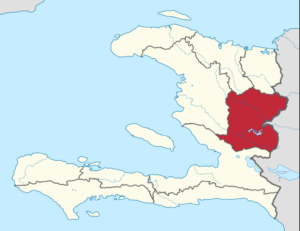
Touristic sites
The Central Plateau is not only an area protected from earthquakes and hurricanes but also a region dotted with tourist sites.
The Bassin Zim waterfall, which is not far from Papaye in the municipality of Hinche, could attract hundreds of visitors a day. But the lack of infrastructures, and the erosion which decreases the flow of the fall will undoubtedly cause the disappearance of this heritage within a few years.
The Layaye and Saltadère caves located in the Juanaria section (municipality of Hinche) sometimes release hot and cold water. They could, according to the inhabitants of the area serve as a pole of attraction for tourists. For the time being, according to them, they harbor only misery and desolation.
Saut-d'Eau, declared a Natural Park, is a fertile land, where there is plenty of water. Saut d'eau is located 65 km (40 miles) from the capital with a large, rich and diversified vegetation cover. Thanks to its famous mystical caves, notably those of Marotière and Doco, Saut d'eau could become the biggest tourist destination in the country.
Saut d'Eau is also a high place of pilgrimage given the presence of sites such as the Immaculate, Calvary, and Palms.
A few km from the center of Hinche, in the locality of Colladère, a fantastic cave houses tools from the pre-Columbian period. This cave is unique throughout the Haitian territory.
There is also the Péligre hydroelectric plant which has served the capital since 1971, and which must supply the town of Hinche. The dam, 72 m (236 ft.) high, operates from an artificial lake, Lac de Péligre, which can also be a tourist attraction.
For some time, access to part of the Central Plateau has been improved thanks to the National Road #3.
It remains that it would be necessary to be able to exploit this tourist potential, to relaunch economic activity and guarantee the community significant entrances.
Geographic landmarks
The Center Department has an area of 3,750 km2 (1,448 sq.mi), or 14% of the area of the national territory. It is the third in area after the Western and the Artibonite Departments and its population is 600,000 inhabitants.
The Central Plateau corresponds to a vast basin bordered to the north by the Northern Mountain Range, to the west by the Montagnes Noires, to the south by the Trou d'Eau Mountains and to the east by the Bassin de San Juan de la Dominican Republic. In its northwest part, this department presents rugged aspects with altitudes of more than 1000 m (3,280 ft.) in the Black Mountains and inclines towards the east; the southeast, much more hilly, is with altitudes of 125 m (410 ft.) in the Péligre dam area.
The Central Plateau is one of the regions with high rainfall. It records an annual average water level of 1,500 mm (59 inches). From April to June, the trade winds penetrate deeper into the Dominican Republic and go up the San Juan Valley to reach the central zone of Haiti. They bring abundant precipitation to which is added, in October, the precipitation brought by the east winds which also go up the San Juan Valley, according to the Bureau of Mines and Energy (BME).
The Center Department comprises four arrondissements, Hinche, Mirebalais, Lascahobas and Cerca-La-Source. It also includes twelve municipalities, four neighborhoods and 35 communal sections.
References
Haïti : Penser la reconstruction avec le Plateau Central [1]
HINCHE: Urban City
37,370 to 50,000 habitants
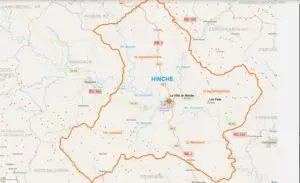
Hinche is a city in Haiti that is located 72 km northeast of Port-au-Prince. The city was founded in 1502 and became a Spanish city in 1720 before becoming a Haitian city again in 1794. Hinche was raised to the rank of commune in 1794 and became the capital of the Center department in 1976. The population of the metro area was estimated to be 50,000 in 2003, and the population of the commune was estimated to be 102,745 people. Hinche is known for its traditional economic activities, such as coffee, sugar cane, sisal, cotton, fruit, livestock, and beekeeping.
Hinche has one district, Quartier Los Palis, and four communal sections: Marmont, Aguahedionde (Left Bank), Juanaria, and Aguahedionde (Right Bank). The city is located on a plateau and has a normal climate. Hinche has three rivers, eleven springs, and several wells and public fountains. Only the town of Hinche is electrified, and the Electricity of Haiti provides an average of seventy-seven hours of current per week. Hinche has a telephone service with 800 lines, but only 733 are functional. The town has a limited postal service and does not have a newspaper or television station.
Hinche has several educational institutions, including two kindergartens, 244 primary schools (including 231 private schools), ten literacy centers, eight secondary schools, three technical and professional centers, one law school, and a private institution of higher education. The municipality also has three religious institutions, including one hospital, one health center, and one asylum. There are fifty-four temples in Hinche, and the Baptist temples are the most numerous, with twenty-three in total.
Hinche's economy is based on agriculture, livestock, and trade. The municipality has several commercial establishments, including three hotels, three restaurants, one bank, and one marketing cooperative. Tourist activities are almost non-existent due to the lack of road infrastructure, but there are several sites in the town that could attract visitors. Hinche has one library and two theaters, but it does not have a museum or cinema.
In terms of politics and organizations, Hinche has one political party and several organizations and groups affiliated with large cooperatives, such as the Papaye Peasant Movement and the Pou Tout Moun organization. The municipality has representatives from several government ministries, including the Ministry of Commerce, the Ministry of Social Affairs, the Ministry of Economy and Finance, and the Ministry of Planning and External Cooperation.
Hinche is a city with a rich history and traditional economic activities. While it lacks some modern amenities and infrastructure, it has a thriving educational system and a strong agricultural and commercial sector. Although tourist activities are limited, Hinche has many sites of natural beauty and cultural interest.
FIRST SECTION (rural section)
- Juanaria
- 23,135 habitants
LOCALITIES
( Abricot, Bois Magot, Bois Rouge, Bourouc, Ca Laville,Caredouc, Carissade, Carrelouc, Casimir, Ducastre, La Croix, La Fleur-du-Sept, La Guam, La Rochiquitte, La Vallée, Les Lattes, Locanone, Mare-Maringuin, Nan Chamboum, Nan Hac, Nan Kinge, Nan Rocher, Nan Train, Ounaraia, Pantassou, Paradis, Pedrogomme, Pierre-Brisard, Principe, Regalie, Reposoir, Rincon, Roche-à-Pierre, Roche-Pilé, Roche-Plate, Rosalie, Salmony, Savane-à-Lagues, Savane-Halaine, Savane-Line, Savanette, Tablon, Terre-Cassée)
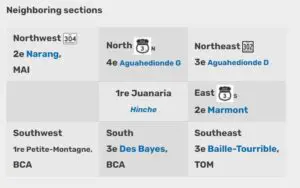
SECOND SECTION COMUNAL (rural)
- MARMONT
- 16,670 habitants

Map
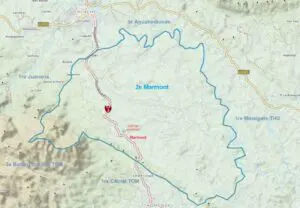
Localities
(Baycite, Bintorrible, Caraba, Caraplaine, Danizard, Doco, Dolo, Dos Roche, Hatte-Cantave, La Bègue, La Cour-Gadichon, La Hine, La Mécette, Lapati, Latrémare, Lomoraine, Malary, Marmont, Méréhil, Mme Georges, Pabdocal, Quépont, Ravine-Fond, Samadère, San Jose, Sapaterre, Savanette, Tamarin)
THRID SECTION COMUNALE (rural section)
- Aguahedionde
- 20,312 habitants
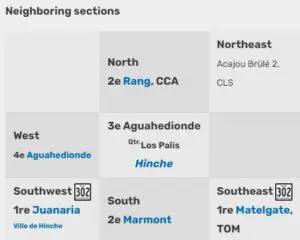
Map
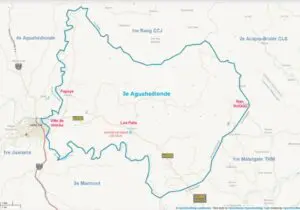
Localities
(Ange-de-Joie, Bailly, Bas Jacob, Bassin-Beouf, Bassin-Soleil, Caba-Soleil, Cahobé, Canielle, Carobite, Démarague, Dlo Coq, Fond-Miguel, Fond-Piquant, Garde, Garde-Savane, Haut-Jacob, Jacob, Lacabri, La Cange, Laguardiane, La Partie, Le Higuey, Losannone, Los Palis, Nan Dalle, Nan Pomme, Nan Raquette, Nan Roseau, Nan Saut, Nan Ti Palto, Palma, Palsata, Platarage, Saint-Léger, Sansou, Savane Papaye, Tchaque, Terre Blanche)
FOURTH SECTION COMUNALE (rural )
Left Rive
- Aguahedionde
- 22,115 habitants
About
Also spelled Aguahidionde, this communal section was created in 1875. Mahogany wood is found here.
Route Nationale 3 is the main road through the community. It intersects with Route Departmentale 305 at Carrefour Cerca in the Colladère neighborhood.
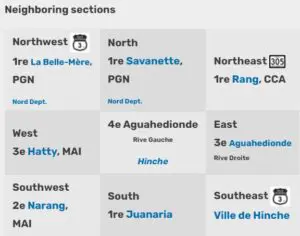
Localities
(Began-Nabé, Boroc, Ca Soie, Cayahonde, Céde, Colladère, Corbana, En-Bas-Colladère, Grand-Latanier, Guanide, Hatte Pére, Jasmin, La Belonne, Laboc, La Boqué, La Chacone, La Gardule, Lata, Liblanc, Lorodiague, Los Mamones, Los Pines, Mac-Bonite, Maria-Lapa, Mauric, Menis, Nan Bois d'orme, Nan Couine, Nan Vincent, Pecaique, Poloa, Ramadie, Rodé, Samana, Vieux Parc)
The community development unit program is a collaborative effort between the local team in Hinche and LEVE INTERNATIONAL. Every three months, the local team meets with leaders of each section communale to better understand their struggles. The farmers of the first section communale of Juanaria are facing numerous challenges such as the lack of agricultural tools, inability to afford labor costs, lack of quality seeds, and absence of irrigation systems, making them plan only during rainy seasons. In several remote areas, there are no roads for cars and only horses and donkeys can access those areas. They do not receive any support or subsidies from the Haitian government, which puts them in a state of complete despair.
The local leaders proposed an innovative idea to revitalize agriculture in the first section communale of Hinche, which was sponsored by LEVE INTERNATIONAL. The project is called "Konbit" or collaborative community leadership model, where farmers are organized into different teams and provided with 80 pieces of agricultural equipment, which are managed by the community development units free of charge. The community development units coordinate among the farmers and bring the tools to each other's farms, reducing labor costs. Since the project started in April 2022, over 100 community development unit initiatives have been undertaken. The farmers have expressed their satisfaction with the project's implementation. Currently, LEVE INTERNATIONAL and the local leaders in Hinche enjoy trust and unwavering partnership amongst the community.
In summary, the community development unit program is a successful partnership between LEVE INTERNATIONAL and the local team in Hinche. The program has provided farmers in the first section communale of Juanaria with essential agricultural tools and resources, which have helped to revitalize agriculture in the region. The community development unit project has strengthened the bond among the farmers and contributed to the overall well-being of the community.
The success of a program in rural Hinche presents an opportunity for expansion into additional sections of the community. The program has proven successful in teaching farmers about team work and collaborative leadership, and there is potential for additional benefits with the provision of quality seeds, education and training from local agricultural engineers, and the implementation of innovative farming approaches such as regenerative agriculture and aquaponic systems. The organization behind the program, LEVE INTERNATIONAL, believes that fostering a relationship with the local community can further improve the well-being of rural Hinche. By providing education and training, farmers can become more self-sufficient and sustainable in their practices, leading to increased food security and economic development in the region. It is believed that this initiative can be replicated in other sections of Hinche to create an even greater impact. Through collaboration and innovation, the potential for positive change in Hinche is significant.
We make it convenient for you to get involved or to stay connected with the local farmers and the local team in Hinche.
-
Virtual Meetings: Schedule a virtual meeting with the farmers and our local team to learn more about their needs, challenges, and opportunities. This will allow you to connect with the farmers in real-time, and get a better understanding of their situation. You can use video conferencing tools like Zoom, Skype, or Google Meet to conduct these meetings.
-
Volunteer Opportunities: If you have expertise in a particular area, consider volunteering your time to help the farmers in Hinche. For example, if you have experience in marketing, you can help the farmers develop marketing strategies to promote their products. You can also volunteer your time to teach them new farming techniques or provide them with training in a particular area.
-
Coaching and Mentoring: If you have experience working with farmers or in a related field, you can offer to coach or mentor our local team. This will help them build their skills and knowledge, and allow them to better support the farmers in Hinche.
-
Blog Updates: Keep an eye on our blog to stay up-to-date with the latest developments from Hinche. This will allow you to stay informed about the progress being made and any challenges that arise. You can also use the blog to share your own insights and ideas with others who are interested in supporting the farmers in Hinche.
Overall, staying connected with the farmers in Hinche requires a combination of communication, collaboration, and support. By leveraging your expertise, time, and resources, you can help make a positive difference in the lives of these farmers and their communities.
